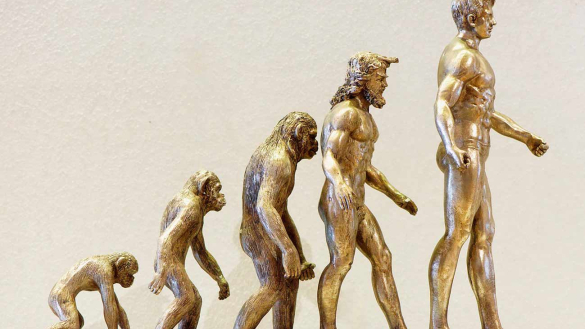We stood to eat leaves

The results of two studies set back the origins of apes and the evolution of grassy forests by 10 million years in Africa, and shed light on the origins of apes. These results push back the origin of grassy forests from 7 to 10 million years ago to 21 million years ago in equatorial Africa, during the early Miocene.
Anthropologists have long believed that our ape ancestors evolved an erect trunk for plucking fruit in the forest, but new research from the University of Michigan suggests that life in open forests and a diet that includes leaves is what drove the apes’ upright stature.
The trick is to free your hands
The fruit grows on the thin tips of the trees. To reach it, the great apes need to distribute their weight on branches extending from the trunk and then reach for their prize. This is much easier then The monkey stands upright because it can easily grab different branches with its hands and feet. If its back is horizontal, its hands and feet are usually below the body, which makes it more difficult to move on the small branches of the tree, especially if the monkey has a large body.
This is how modern monkeys access fruit, and the theory goes that this is why monkeys evolved to be upright,” according to the University of Michigan researchers. Laura McClatchy And John Kingston .
The answer is a million-year-old fossil
But new research focusing on a 21-million-year-old fossil ape named Morotopithecus and led by MacLatchy suggests that may not be the case. Instead, the researchers believe, the first apes ate leaves and lived in seasonal forests with broken canopy and grassy areas. The researchers suggest that it was this landscape, rather than the fruits found in forests with closed canopies, that drove the monkeys’ upright stature.
Your search results Published in Science and supported by a companion article examining ancient forest habitats, published in the same issue of the journal.
“The expectation was: We have this monkey with an erect back. It must live in forests and it must eat fruit. But as more and more information became available, the first thing that struck us was that the monkey was eating leaves,” said McClatchy, a paleoanthropologist and professor in the UM Department of Anthropology. The second surprise was that she lives in the forests.
The two papers arose from a US National Science Foundation-funded collaboration of international paleontologists, known collectively as the Research on Catarrina in East Africa and Human Evolution, or REACH, each focusing on different aspects of the ancient environments of the first apes. The study led by MacLatchy focuses on a 21-million-year-old site called the Moroto Site in eastern Uganda.
There, the group, which included MM University researchers William Sanders and Miranda Cosman, examined fossils found in a single layer, including those of the oldest and best-documented ape, Morotopithecus. Also within this layer were fossils of other mammals, ancient soils called paleosols, and tiny particles of silica called phytoliths. The researchers used this evidence to recreate the ancient environment of Morotopithecus.
MacLatchy and Kingston found that plants living in this landscape experienced what’s called “water stress,” which means they lived through seasonal periods of rain and drought. It also means that at least part of the year, The monkeys had to rely on more than just fruit to survive. Together, these results indicate that Morotopithecus lived in an open forest cut by broken forests made up of trees and shrubs.
Early Miocene C4 pastures and open woodlands
Previously, researchers thought that tropical Africa during the early Miocene was heavily forested, as seasonal open forests and grasslands developed only 7 to 10 million years ago.
But the second article, Also published in Science, uses a combination of ecological proxies to reconstruct the plant structure of nine fossil ape sites in Africa, including the Moroto site, during the early Miocene. These proxies revealed that C4 grasses were “ubiquitous” at fossil monkey sites during that time period, said Kingston, a biological anthropologist and assistant professor in the Department of Anthropology at Imperial University. “This paper looks at all of these locations, puts all of this data together, and says, ‘Look, no matter how you evaluate the data, there’s no way you can get away from the fact that all these proxies converge in the same place, which means that these The environments are open, open with C4 weeds.”
For the first time, we show that these grasses are widespread, and it is this general context of seasonal open forest ecosystems that has been integral in shaping the evolution of different mammalian lineages, including, and particularly in our case, how mammals evolved differently. Lineages of monkeys.
The nine sites are spread across eastern equatorial Africa, enough to establish a “regional picture” of what the sites’ landscapes looked like in the early Miocene, Kingston said. During this time, the East African Rift was forming. The earth was disintegrating. As a result, the level of the whole region was raised, causing great variation in topography, and thus in regional climate and vegetation.
The studies published by Science are:
Evolution of hominin locomotor diversity: evidence from Moroto, site 21 Ma in Uganda. Laura M. MacLatchy, The evolution of human locomotor versatility: Evidence from Moroto, Site 21 Ma in Uganda, Available here. Sciences (2023). DOI: 10.1126/science.abq2835. www.science.org/doi/10.1126/science.abq2835
The oldest evidence of C4 grass abundance and habitat heterogeneity is in East Africa. Daniel J. Peppe et al, Oldest Evidence for C4 Grasses Abundance and Habitat Heterogeneity in East Africa, Sciences (2023). DOI: 10.1126/science.abq2834. www.science.org/doi/10.1126/science.abq2834
fountain: University of Michigan

“Coffee fanatic. Gamer. Award-winning zombie lover. Student. Hardcore internet advocate. Twitter guru. Subtly charming bacon nerd. Thinker.”











